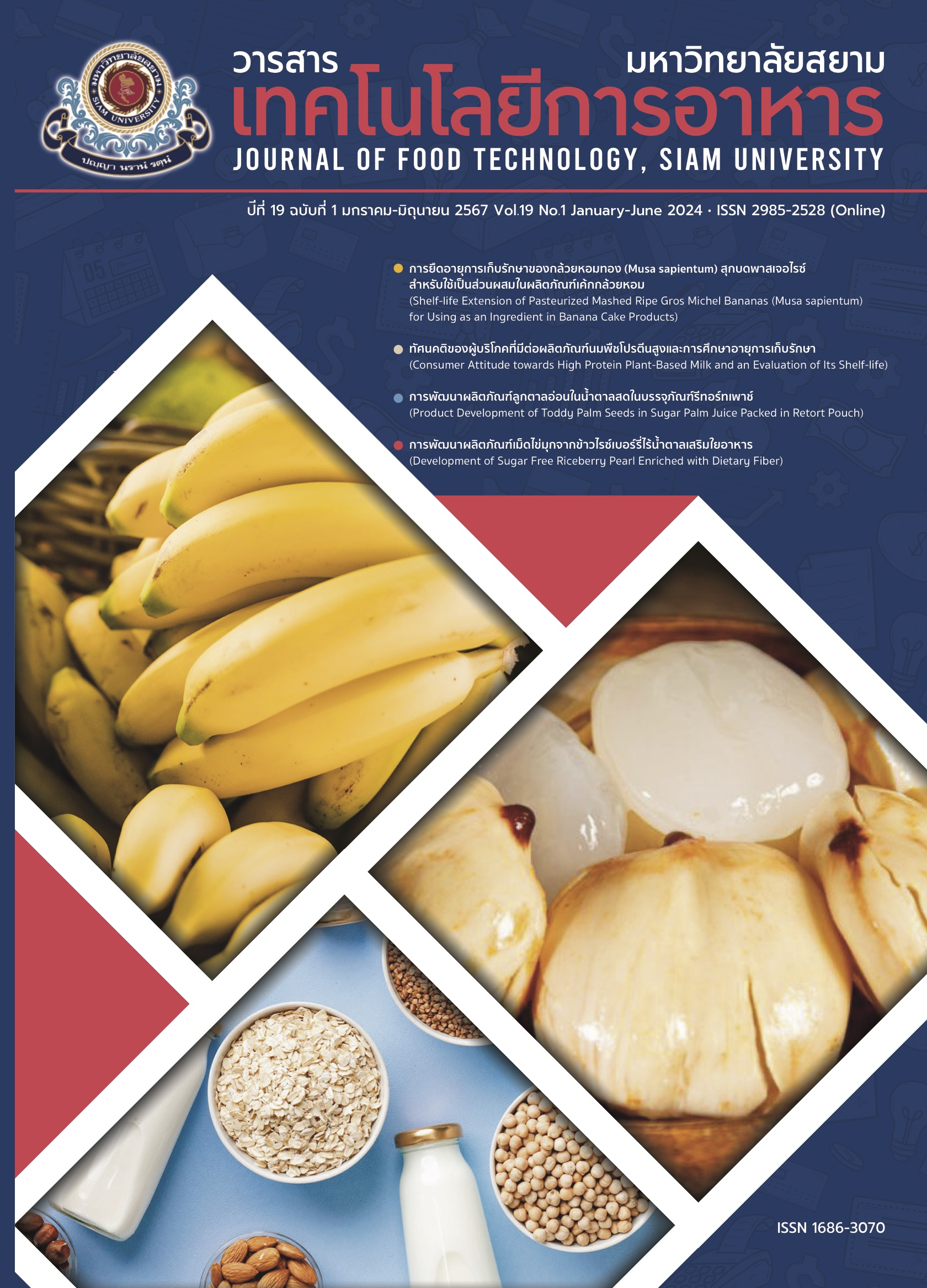Consumer Attitude towards High Protein Plant-Based Milk and an Evaluation of Its Shelf-life
Main Article Content
Abstract
The objective of this research was to develop a high-protein red bean milk product using concentrated red bean protein and a sterilization method. The ideas for the product development were taken from a study of consumer attitudes which used the laddering technique and the shelf-life of the product was also evaluated. The results of the study on the health and nutritional attitudes of 30 consumers found that consumers could be divided into 2 groups according to their health consciousness scores (Group 1 = 5.71 points and Group 2 = 3.63 points) and their interest in dairy products from plants (Group 1 = 5.86 points and Group 2 = 3.69 points). The attitudes of the Group 1 test-taker towards the red bean milk products were that it contained high protein, a delicious taste, was sweet without sugar, was not viscous, and had attractive packaging. The red bean milk formula was developed by adding 5.7 grams of concentrated red bean protein per 100 milliliters, so that it could claim to have a high protein content, according to the Ministry of Public Health Announcement (No. 445), 2023. The product shelf-life was studied under accelerated conditions at 35, and 45 degrees Celsius for 3 months. It was found that the products stored under these conditions at 35 and 45 degrees Celsius showed an increase in yellowness, while pH, total solid content, and consumer acceptance were significantly decreased. We assessed Q10 of the test by identifying a pH drop below 4.3 as an unacceptable criterion. It was found that the product has a shelf life of approximately 269.4 days at 25 degrees Celsius. Therefore, we can further utilize this research to develop plant-based milk products that align with consumer needs.
Article Details

This work is licensed under a Creative Commons Attribution-NonCommercial-NoDerivatives 4.0 International License.
Copyrights of all articles in the Journal of Food Technology available in print or online are owned by Siam University and protected by law.
References
Data bridge market research. (2023). Plant-based milk market. [Online] Available from https://www.globenewswire.com/ news-release/2023/03/27/2635196/0/en/ Plant- Based- Milk- Market- to-Perceive-Highest –Growth -of- USD-50-066-21-Million-by-2030-Size-Share –Trends –Key -Drivers-Growth- Challenges –and -Opportunity-Forecast.html [Accessed November 2, 2023].
Strategic market research. (2022). Global plant based milk market. [Online] Available from https://www.strategicmarket research.com/market-report/plant-based -milk-market [Accessed January 25, 2023].
Olson, J.C. (1989). Theoretical foundations of means-end chains. Werbeforschung and Praxis Folge. 5: 174–178.
Waruttama, S. (2015).Using the theory of psychological hierarchy to study and understand the values of recipients. Eyebrow tattoo service. Master's thesis. College of Management, Mahidol University. Bangkok, Thailand. (in Thai).
Ngampeerapong, N., Dhamvithee, P. and Chantrapornchai, W. (2012). Study of attitude of consumer on jam using laddering interview technique. The 50th Kasetsart University Annual Conference. KC5006033. 276-283. (in Thai).
Chaisawat, C. (2014). The factors and values affected to female consumer’s purchase decision of organic skincare products by the means end chain theory. Master’s Thesis, College of Management, Mahidol University. Bangkok, Thailand. (in Thai).
Ares, G., Giménez, A., and Gámbaro, A. (2008). Understanding consumers’ perception of conventional and functional yogurts using word association and hard laddering. Food Quality and Preference. 19(7): 636-643.
Ahmed, J., Al-Ruwaih, N., Mulla, M., and Rahman, M.H. (2018). Effect of high pressure treatment on functional, rheological and structural properties of kidney bean protein isolate. LWT -Food Science and Technology. 91: 191-197.
Aydar, E.F., Tutuncu, S., and Ozcelik, B. (2020). Plant-based milk substitutes: bioactive compounds, conventional and novel processes, bioavailability studies, and health effects. Journal of Functional Foods. 70: 103975.
Aydar, E.F., Mertdinç, Z., Demircan, E., Çetinkaya, S.K., and Özçelik, B. (2023). Kidney bean (Phaseolus vulgaris L.) milk substitute as a novel plant-based drink: fatty acid profile, antioxidant activity, in-vitro phenolic bio-accessibility and sensory characteristics. Innovative Food Science & Emerging Technologies. 83: 103254.
Reynolds, T.J. and Gutman, J. (1988). Laddering theory, method, analysis, and interpretation. Journal of advertising research. 28(1): 11-31. https://psycnet.apa.org/record/2001-01229-001.
AOAC. (1990). Official methods of analysis of AOAC. (15th ed). The Association of official Analytical Chemists, Arlington.
Thanakit, T., Pilai, R., and Dusadee, B. (2018). Evaluation of product shelf-life mulberry leaf tea mixed with mulberry fruit using the accelerated method. Agricultural Journal. 34(1): 157-166. (in Thai).
Haas, R., Schnepps, A., Pichler, A., and Meixner, O. (2019). Cow milk versus plant-based milk substitutes: a comparison of product image and motivational structure of consumption. Sustainability. 11(18): 5046. doi: 10.3390/su11185046.
Short, E.C., Kinchla, A.J., and Nolden, A.A. (2021). Plant-based cheeses: a systematic review of sensory evaluation studies and strategies to increase consumer acceptance. Foods. 10(4): 725. doi: 10.3390/foods10040725.
Moss, R., Barker, S., Falkeisen, A., Gorman, M., Knowles, S., and McSweeney, M.B. (2022). An investigation into consumer perception and attitudes towards plant-based alternatives to milk. Food Research International. 159(1): 111648.
Narayanan, K.A., Kumar, A., and Patil, G.R. (1993). Kinetics of various deteriorative changes during storage of UHT soy beverage and development of a shelf-life prediction model. LWT- Food Science and Technology. 26(3): 191-197. doi: 10.1016/j.foodres.2022.111648.
Achouri, A., Boye, J.I., and Zamani, Y. (2007). Changes in soymilk quality as a function of composition and storage. Journal of Food Quality. 30(5): 731-744.
Khodke, S.U., Shinde, K.S., and Yenge, G.B. (2014). A study on the storage of sterilized soymilk. International Journal of Farm Sciences. 4(4): 166-179.
Wattanasin, S. (2006). Food microbiology. (2nd ed). Thammasat University Printing House, Thailand. (in Thai).
Meng, G. and Ma, C.-Y. (2002). Characterization of globulin from Phaseolus angularis (red bean). International Journal of Food Science & Technology. 37: 687-695. https://doi.org/10.1046/j.1365-2621. 2002. 00601.x.
Roland, I.S., Le, T.T., Chen, T., Aguilera-Toro, M., Nielsen, S.D., Larsen, L.B., and Poulsen, N.A. (2024). Storage stability of plant-based drinks related to proteolysis and generation of free amino acids. Foods. 13(3): 367. doi:10.3390/ foods13030367.


